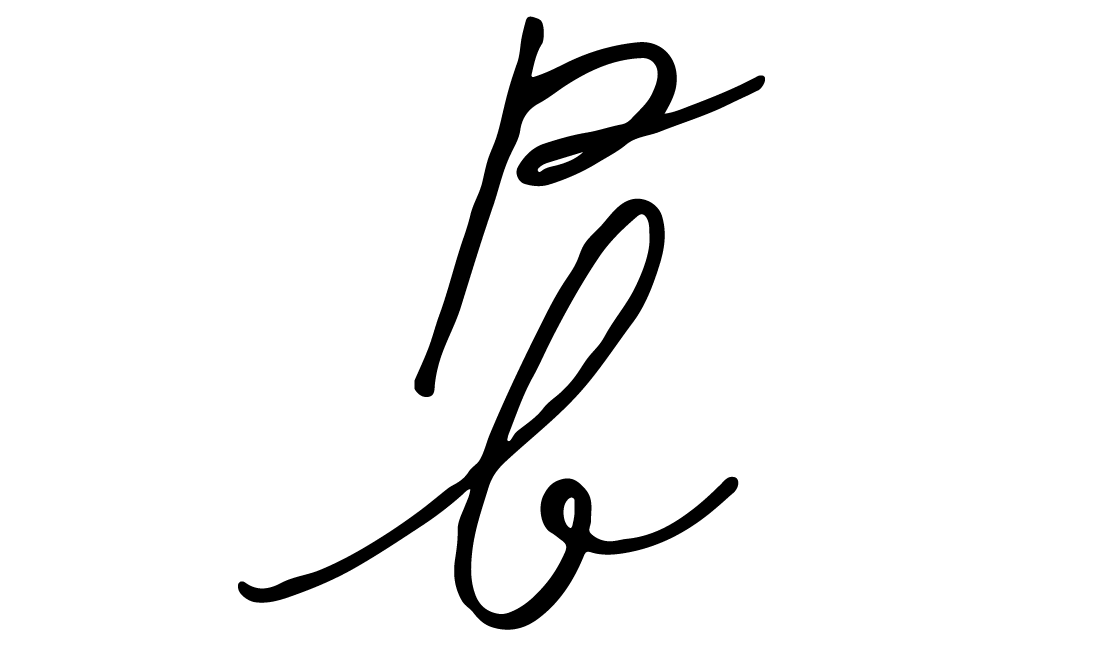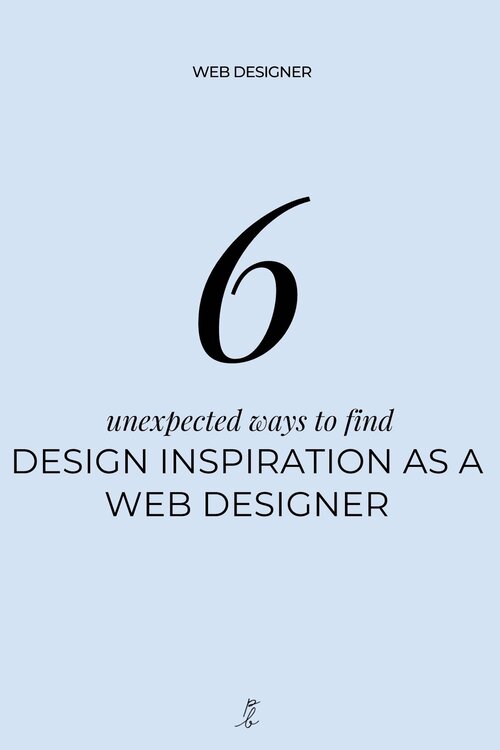6 unexpected ways to find inspiration as a web designer
Prefer to watch?
HERE’S THAT VIDEO FOR YA!
MENTIONED IN THE VIDEO:
Free Training! 4 simple steps to DOUBLE your site sales
There’s nothing worse than getting stuck in a creative rut as a web designer!
This thing that used to bring you so much joy, felt like the perfect creative outlet, and that you couldn’t believe you were actually being paid to do, now suddenly starts to feel like a chore.
When you’re stuck in this trap, every time you sit down to start designing, the narrative in your head starts up…
“Everything I create is starting to look the exact same.”
“I’m no good at coming up with new ideas. Literally everything I do has been done before.”
“I’ll never be as creative as so-and-so.”
Sound familiar?
If this you, and you’re seriously starting to doubt your creativity as a designer, then I hope to use this post to give you some fresh inspiration!
But not from the usual sources…
(Like the work of other designers!)
So keep reading for those unexpected places to be finding creative new design ideas!
BUT while we are making it pretty, let’s not forget to look at the strategy behind our design, as well.
If up until this point, all your website design decisions have been 100% shaped by aesthetic, or what looks good or is currently trending, then I hate to tell you this…
But you are absolutely leaving money on the table!
Money for yourself and money for the clients you design for!
I recently recorded a 60-minute webinar where I go over the most common site strategy mistakes I see even experienced designers making that could be having a pretty serious effect on how often they are actually managing to turn site browsers into buyers.
I definitely suggest hitting pause for a sec to get access to that free training now so that when you DO go to start implementing all your fresh design ideas from today’s post, you can be sure your bases are covered strategy-wise as well. 👇
How to find website design inspiration as a web designer
(Without copying the work of other designers)
Source #1:
Go shopping
For real though. Consider it your homework!
Not with the purpose of actually buying anything, but with the sole intention of paying closer attention to your surroundings, and soaking up all the secrets of your ideal client’s universe.
So how does it work?
Step 1:
Go to your client’s happy place
Pick the shops you know that your ideal clients happen to be obsessed with.
Is your ideal client just like you? Perfect. Shop where you love to shop!
But otherwise, try to get inside the head of the person you are most passionate about serving with your business, and then scope out the stores they could spend hours in.
This might look like wandering the aisles of Target, getting lost in Cabellas, or touching every last thing on display at Anthropologie.
Or maybe it’s not a retail location, but still a business your ideal client would be likely to frequent like a boutique bakery, a hot new salon, or a trendy little coffee shop.
Step 2:
Look for hidden design clues
There’s a reason your ideal person could spend all day in their favorite stores…why not see if you can figure out what that reason is?
What vibe are these businesses putting off that is so attractive to your dream client? What colors, shapes, textures, patterns, and symbols are you spotting on repeat?
What materials are they using in their display windows, backdrops, and changing rooms that have your client feeling so at home in their store?
You’d be surprised at how much market research goes into even the smallest design/decor decisions of stick & brick store locations, so why not piggyback on their efforts, and learn everything you can about your audience from their fav store’s example?
Take note of all the little details you would normally overlook but somehow add to the overall experience of that store, and find ways to introduce those client-attracting elements into your own designs!
Can’t make it to a physical store?
Sign up for their emails!
Larger companies especially will have hired pro-designers to take their market research and what they have learned about their target audience (which happens to be your target audience) and apply it to the design and functionality of their promo emails.
So it wouldn’t hurt to take a peek at some of the layouts, colors, elements, and style choices of your ideal client’s favorite shop’s virtual storefronts too!
Source #2:
Pay attention to product packaging
Another way to make the most of the shopping you do in your everyday life is to start looking long and hard at your favorite brands’ product packaging.
Again, consumer psychology & market research is a very real thing, and these company’s paid out massive chunks of change to make sure that their products not only work, but actually look like something their target audience is going to want to buy.
There’s obviously a few other factors as to why we make the purchasing decisions we do (ingredient lists, difference in price points, etc.)…
But when you’re standing in an aisle, looking at a wall of 37 different types of mascara, the packaging is usually going to be what subconsciously seals the deal.
Say your ideal clients dream of high-fashion, dining on caviar, and luxurious nights out on the town.
The flashy packaging featuring impossibly high stilettos, and the ultra-sultry cat eye look is probably going to speak to them much more than the 100% recycled brown paper packaging with the minimal font and a simple sprig of greenery on the front.
So look at the everyday household items you are purchasing and ask yourself what it was that drew you to that product over the other options on the shelf.
Then start to incorporate those same vibes into your work for clients.
Source #3:
Stalk people’s home makeovers
I’m not suggesting you stalk people in their actual homes…just to be clear.
But nothing is more satisfying than a good before and after!
So next time you are scrolling the ‘Gram and dreaming of all the updates you want to make to your current fixer upper, look for trending themes.
What are the lines like? Clean and straight? Soft and welcoming? Abstract and unexpected?
What about the transitions from room to room? Does one flow into the next? Or is there sharp contrast between each space?
Are the colors monochromatic and understated? Or a bit on the wild side? And the fabric and wallpaper patterns you are seeing…and they more simple and delicate or busy and ‘loud?’
A perfect example is the recent arches trend popping up in Instagram-able homes everywhere.
Doorways, wardrobes, windows, wall cutouts…forget corners! The people have spoken, and they want arches.
So sure enough, web designers and graphic designers everywhere are following suit.
Rarely do clients know exactly what they want their website to look like. It’s more of a “I’ll know it when I see it” situation, and a connection to something that feels familiar.
So when you can take inspiration from things they are already drawn to in other industries, you’ll have no trouble making sure your portfolio speaks to your ideal person.
So don’t just wait to hop on design trends you’re seeing in other web designer’s portfolios!
Be proactive and search for those patterns and trends yourself in the other types of content (like interior design) that your clients are likely to be consuming.
Source #4
Scan your playlist for album art
Let me share a little example of this that I recently spotted out in the wild…
So because I’m always consuming online business related content online, you can bet that 99% of the ads I’m being served have something to do with online business.
There was recently one ad in particular that got my attention because it was just so pretty and on-trend looking.
Well, as one does, I got sucked into reading the comments on the post…and several people had commented on the fact that they were initially drawn to this ad because it reminded them of the new Demi Lovato album cover art.
So think of the type of music or podcasts your ideal person might be listening to on repeat, and check out the album art to see if you can drum up some inspiration that way! (See what I did there?) 🥁 🎶
Source #5
Follow completely unrelated Instagram accounts
Stuffing your feed full of nothing but other web designers is the surest way to make sure your work ends up looking like everybody else’s.
It’s pretty hard to unsee a design you’ve fallen in love with!
If you are constantly consuming other people’s portfolios, every time you sit down to come up with a design for a client, you’ll be flooded with images of their work.
Inspiration can quickly turn into comparison, and you may even start to doubt your own abilities as a designer. (Which only throws you deeper into a creative rut!)
So while peeping other people’s portfolios can be inspiring, try hitting pause and temporarily muting those accounts in favor of following people in totally unrelated (but still eye-catching) niches.
Taking in examples from other visually driven industries can go a long way in waking up your creativity, without the risk of straight up copying someone else’s website.
Think: custom cookie decorators, stationary makers, travel bloggers, fashion influencers, painters, brand photographers, interior designers, and macramé weavers.
Whatever they do, find examples of their work that speaks to you (or you think would speak to your ideal person) and find a way to translate that concept into your own unique designs.
Source #6:
Practice creativity (the mood board Monday exercise)
As designers, we get so wrapped up in growing our businesses and trying to find clients that sometimes we forget to take time to feed into the thing that actually fuels our entire business: creativity!
If we want the ideas to flow freely, we can’t just wait and do all our designing when the stakes are high and a client has just handed over $5K+ for you to not mess up their site.
What if you did away with all the pressure of having to please anyone just set aside a time to create for you.
To create just for the sake of learning to create!
You wouldn’t show up to the Boston marathon without first having trained at home.
Creativity is the same way…it’s a muscle that needs constant strengthening and stretching if you’re going to stay in the race.
A super quick and easy way to practice creativity as a web designer is to set aside a time each week to come up with a few simple mood boards.
(I’m calling it mood board Monday for the obvious ‘cutsie’ factor, but rest assured you can do this any day of the week.)
How to make your web design inspiration mood board
Make yourself a secret Pinterest board and name it whatever vibe or design aesthetic you want to practice nailing that day. Maybe it’s ‘modern masculine’, ‘monochromatic chic’, or ‘extra bold & funky’.
Whatever it is, look for images that align with that aesthetic & feeling (textures, photographs, fonts, colors, words or quotes, etc.) and pin them to your secret Pinterest board.
Then bring those same images into something like Canva or Adobe Illustrator, and play around with arranging them in different layouts and shapes.
Yep! Mood boards aren’t just for client projects!
They are a perfect way to get your creative thinking cap on, and to remind yourself that you are good at what you do and you are capable of coming up with great ideas.
Plus, you’ll have a wonderful resource for future clients needing to see a few examples before committing to a certain vibe.
The more often you do this exercise, or really anything you create that is just for you, the more unique inspiration you’ll have saved up for rainy days where creativity doesn’t come as easily to you!







